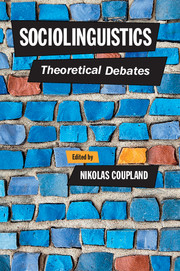Book contents
- Frontmatter
- Contents
- List of contributors
- Preface and acknowledgements
- 1 Introduction: Sociolinguistic theory and the practice of sociolinguistics
- Part I Theorising social meaning
- Part II Language, markets and materiality
- Part III Sociolinguistics, place and mobility
- Part IV Power, mediation and critical sociolinguistics
- 12 Critical debates: Discourse, boundaries and social change
- 13 Theorizing media, mediation and mediatization
- 14 Foucault, Gumperz and governmentality: Interaction, power and subjectivity in the twenty-first century
- Part V Sociolinguistics, contexts and impact
- Part VI The evolution of sociolinguistic theory
- Index
- References
12 - Critical debates: Discourse, boundaries and social change
from Part IV - Power, mediation and critical sociolinguistics
Published online by Cambridge University Press: 05 June 2016
- Frontmatter
- Contents
- List of contributors
- Preface and acknowledgements
- 1 Introduction: Sociolinguistic theory and the practice of sociolinguistics
- Part I Theorising social meaning
- Part II Language, markets and materiality
- Part III Sociolinguistics, place and mobility
- Part IV Power, mediation and critical sociolinguistics
- 12 Critical debates: Discourse, boundaries and social change
- 13 Theorizing media, mediation and mediatization
- 14 Foucault, Gumperz and governmentality: Interaction, power and subjectivity in the twenty-first century
- Part V Sociolinguistics, contexts and impact
- Part VI The evolution of sociolinguistic theory
- Index
- References
Summary
Introduction: shifting boundaries, transforming critique
Language boundaries and categories are a classical sociolinguistic issue in accounts of linguistic diversity and change. However, the status of boundaries and categories is called into question in the complex and shifting terrain of theoretical and political debates (cf. Blommaert, this volume, Chapter 11). How should such boundaries and categories be best understood and defined? One important perspective, adopted in this chapter, is that the construction of sociolinguistic boundaries always involves questions of power. That is, we need to ask when, how, on what grounds, and by whom they are defined and operationalized. These questions have consequences for many key issues of interest in sociolinguistics, including identity and social inequalities. This perspective is often taken as a form of critical language research, although we also need to question what is actually meant by the concept of ‘criticality’.
As a heterogeneous and debated project in itself, the concept of the critical is frequently used in different strands of research into language, power, and social change (see, e.g., Fairclough 1992; Pennycook 2001; 2012; Mesthrie 2009; Heller 2011; Duchêne et al. 2013). Often, theorization of the complex relationships between language, power, and social change, as developed by Foucault, Bourdieu, Bakhtin, and Voloshinov, forms the baseline of critical perspectives, but there are obviously different historical developments and emphases within language research interested in these issues (see, e.g., Woolard 1985; Blommaert 2005; Heller 2011; Wodak 2011). For instance, we can trace back uses of the term ‘critical’ to Critical Linguistics, a perspective developed by linguists and literary theorists at the University of East Anglia in the United Kingdom (Fowler et al. 1979; Kress and Hodge 1979) during the 1970s, aiming to explore relationships between language use and ideologies, basing their work on Halliday's systemic functional linguistics. This work continued in the 1980s under the label of Critical Discourse Analysis (CDA), a heterogeneous approach to the study of language use as part of social practice, with a focus on reproduction of social and political hegemony and power relations (see, e.g., Fairclough 1992; van Dijk 1993; Wodak 1996).
- Type
- Chapter
- Information
- SociolinguisticsTheoretical Debates, pp. 263 - 281Publisher: Cambridge University PressPrint publication year: 2016
References
- 10
- Cited by



